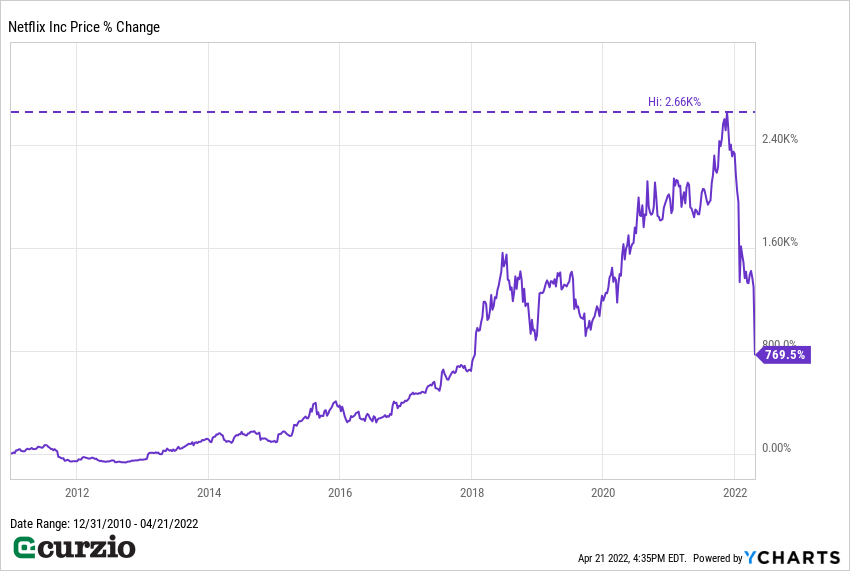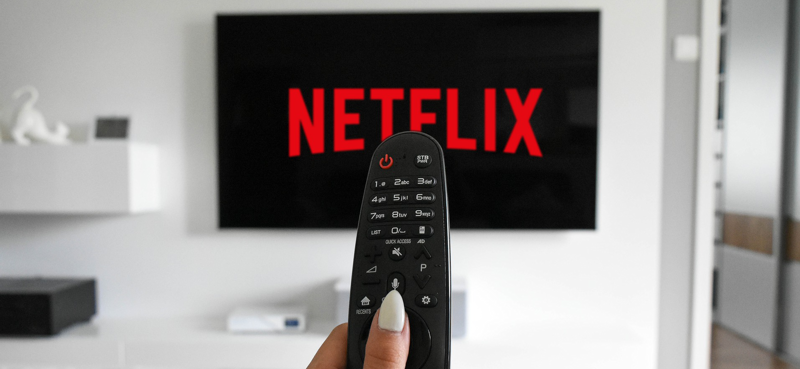You’re probably familiar with the expression: “Don’t try to catch a falling knife.”
Undoubtedly great culinary advice… but it applies to the stock market as well.
Like a falling knife, a plunging stock will probably end up hurting you.
So when a stock starts falling suddenly, use extreme caution. There’s a good chance it has further to fall.
Even Wall Street veterans can find themselves flabbergasted when a large-cap stock loses 35% in a single day.
Do you hold? Sell? Buy more? Is the lower-priced stock a bargain—or a trap?
This week, that large cap was Netflix (NFLX).
This company could do no wrong for more than a decade… As the first mover in the streaming space (helping to make DVDs obsolete), Netflix had come to symbolize innovation in the tech space, alongside the other mega-cap stocks collectively called FAANG.
Netflix plummeted 35% last Wednesday after it reported losing subscribers for the first time in more than a decade.
To make matters worse, it was the second time this year the shares dropped by double digits in a single day. (It also happened after the company reported its Q4 results on January 20.)
Today, Netflix is down more than 63% since the beginning of the year…
And many investors are wondering what to do.
Keep in mind, there’s no “right” answer to this question. And every investor (whose risk tolerance and investment goals are very personal) must decide for themselves which stocks they want to own.
Nevertheless, the Netflix debacle—including its rise and recent fall—offers some important lessons on how to decide whether to sell, sit tight, or buy more of a falling stock.
In fact, the lessons below apply far beyond NFLX… They can help you decide what to do with any stock that suffers a big drop—and even avoid some of the pain from the next big selloff.
Lesson 1: Watch out if the story changes
Big trends come and go. Nobody knows this better than Netflix.
The company was responsible for not one, but two major pivots in its industry—first with its DVD-by-mail service… and then with streaming, which pushed then-dominant Blockbuster (not to mention multiple mom-and-pop stores) out of business.
After spending 2011–2012 in the doldrums (the stock was down as much as 82% at some point during that period), shares of Netflix soared over the past decade as the company introduced streaming and the market realized a new sector leader was emerging.
If you bought Netflix in December 2010 and held on during the selloff of 2011–2012, you’d have been up more than 2,300% by the end of 2021.
To put this return into perspective… Even after falling nearly 70% from its 2021 highs, NFLX is still up more than 760% since December 2010.

But this recent action shows us how quickly the market can react when a story changes for the worse. Years of gains can be wiped out in a few weeks (or even days) of trading.
And Netflix’s story has indeed changed: The streaming space has become increasingly crowded… and the company’s content has declined in quality and quantity.
But don’t beat yourself up if you missed the signs—even highly paid professionals make such mistakes. If you learn from the following two lessons, you’ll further reduce the chance of a single stock blowing up your entire portfolio.
Lesson 2: Watch out for valuation changes
Markets have a way of sorting everything out.
Cheap stocks are cheap for a reason… and expensive valuations need to be justified…
Stocks tend to demand premium valuations when they have advantages vs. the overall market, like faster growth, significant barriers to entry, exceptional management, patent protection, and/or strong brand loyalty from consumers.
But when one—or several—of these factors change, watch out.
In Netflix’s case, the market expects growth to slow sharply, thanks to increasing competition in the space.
And when that happens, a stock can quickly lose its premium multiple… leading to a declining share price, even if profits continue to rise.
Netflix is still a quality, brand-name company. But it no longer demands the premium valuation it once did.
Lesson 3: Watch your position size
Never leave an investment on autopilot…
Do your homework and keep up-to-date on the company and its competitors by reading the most recent quarterly/annual reports and presentations.
If that sounds like too much work, here’s a cheat to make it simpler: The bigger a position gets, the more work you need to do. This step is absolutely mandatory for any stock that appreciates multifold—as NFLX did over the past few years. The more you know about your large positions, the more comfortable you’ll be deciding whether it’s time to take some gains off the table… book some losses… or hang tight.
Of course, because you can never know everything, you’ve got to be prudent in your portfolio management: No single position should overtake your entire portfolio… And remember: Even if you start with a small allocation… as a stock soars higher, it’ll grow to represent a larger percentage of your portfolio.
Always have a target position size in mind… and trim it as it grows. You can reinvest the gains in other (well-researched) positions—which will leave you owning a well-diversified, growing portfolio with much less risk of a big blowup.
These three lessons can help you avoid the next Netflix-sized disaster.
P.S. Falling stocks don’t have to mean massive losses… In fact, they can lead to incredible gains.
Earlier this week in Moneyflow Trader, I recommended a simple way to play the demise of expensive growth stocks—and possibly lock in 110% gains in 5 months.
Join us today at Moneyflow Trader… and learn how to profit from the market’s downside.





















